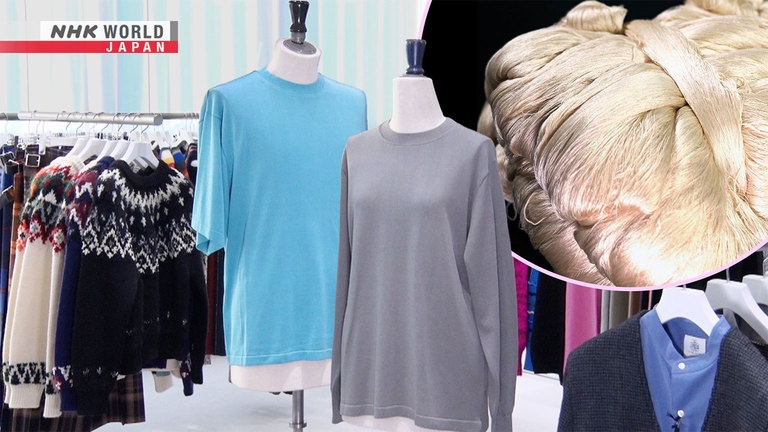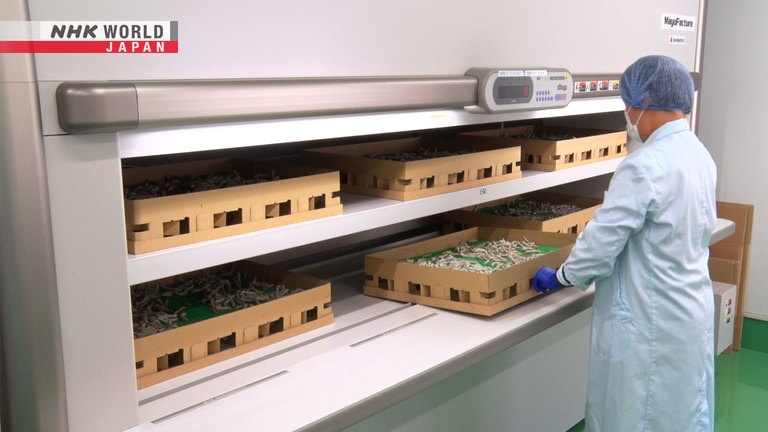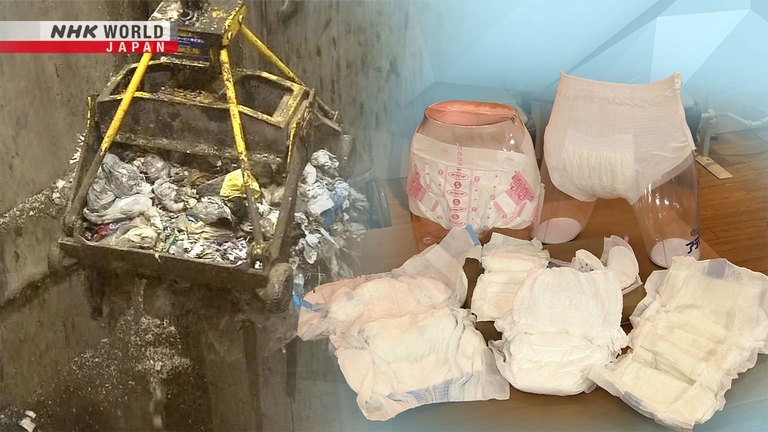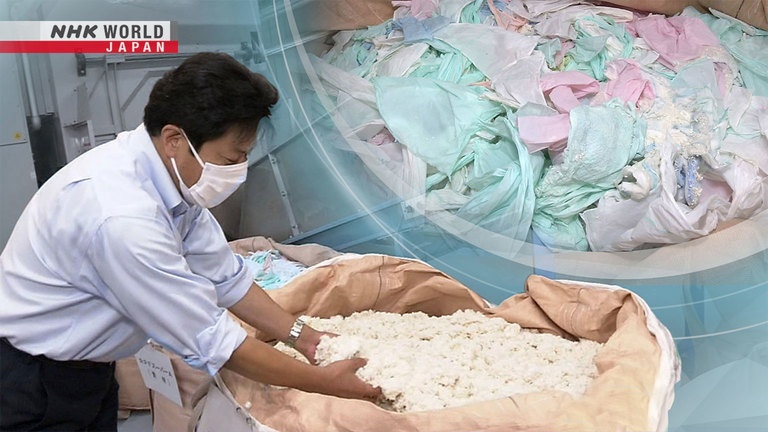Silk Roads to Success
From a machine-washable thread that allows for daily wear to additives for skin care and even food products, this episode focuses on new innovations that are changing the way silk is being produced and used.
[In Focus: A Glimpse Into the Future of Mobility]
Electric vehicles and self-driving technology are reshaping the auto industry. And nowhere is this clearer than at the Japan Mobility Show. NHK WORLD-JAPAN's Yuko Fukushima went there to find out what's in store for the future of transportation.
[Global Trends: Next Recycling Target - Disposable Diapers]
Japan's aging population poses a host of issues, including the disposal of used adult diapers. But some companies are taking on the challenge, finding ways to repurpose what many would consider unrecyclable.
*Subtitles and transcripts are available for video segments when viewed on our website.
Silk Roads to Success

Using a special chemical agent to bond natural silk fibers together on a molecular level results in a much stronger and more resilient type of silk thread.

By using a high-tech automated silkworm farm, this company is able to efficiently produce large amounts of silk proteins for use in a broad range of consumer goods.
Global Trends

Used disposable diapers contain materials that expand after absorbing moisture. This makes them difficult to burn, which means increased CO2 emissions.

This company began by providing a cleaning service for cloth diapers. It then used its experience and technology to develop a means of recycling disposable diapers.
Transcript
The show isn't just for cars anymore.
It now encompasses about anything that fits into the mobility category,
and a record 475 exhibitors presented their vision for the future of transportation.
Take this for example. It's a capsule-like craft being developed by a start-up that's designed to take tourists into space.
But transportation on earth was still the focus, and that means electric vehicles.
This EV from Honda and Sony showed how the segment is bringing in players from other industries.
It will go on sale in 2025.
Meanwhile other firms offered a whole new approach to making EVs.
Welcome to the future, Project X, world premiere!
MIH Consortium unveiled its first electric vehicle prototype.
The group is led by a major contract manufacturer of smartphones, Foxconn.
Just as the company makes iPhones for Apple, the alliance will produce cars for firms under their own brands that are customized to their liking.
If you want to turn the seat off, you can put your cat or your dog in this seat.
Companies just let the consortium know how they want a car done, and the alliance will make it happen.
The group draws on the collective know-how of its roughly 2,700 member companies around the world from various sectors.
They include this Japanese startup developing platforms for autonomous driving...
...and a California-based software company that shares the vision for the future of vehicles.
It's like either the iPhone or Android phone, they have their app stores and they keep their app stores in the open system
so all the developers can contribute to their ideas and to make users' experiences much better.
The CEO of the consortium says software, not hardware, will be key to the auto industry going forward.
As compare to a lot of company, car company, they are very close look. They protect everything within their domain.
And for us we'll open it up and then we'll bring in more of the developers
make sure the future generations software requirement to define the hardware.
That's a revolution.
An expert notes that there are still hurdles to overcome.
What are some of the challenges facing the alliance?
What they need is to partner with especially established auto manufacturers to clear stringent regulatory requirements for safety.
And also to have a capacity of mass production of vehicles.
So car is quite different from smartphone because car is required the high level of safety technology.
In Kamakura City near Tokyo, about 30,000 tons of trash are incinerated annually.
About 10% consists of disposable diapers.
They contain materials that expand after absorbing moisture.
This makes them take longer to burn, which means greater CO2 emissions.
The city's deteriorating incinerator will be taken out of commission in two years.
The plan is to then share facilities with neighboring municipalities, while also trying to reduce garbage volumes by a third.
To achieve this goal, local officials believe it's essential to address the issue of used diapers.
Since their use is projected to grow as the population ages, it's important that we recycle them.
There are about 30 municipalities in Japan that are promoting or considering the recycling of disposable diapers.
And the Environment Ministry has launched an initiative to boost this further.
The government wants to triple the number of municipalities involved by 2030.
The issue has also created opportunities for innovative companies.
This firm got its start by providing cleaning services for cloth diapers.
It's now looking to bring its expertise to recycling disposable ones.
On this day, the company collected a total of about 2 tons of used diapers from 5 elder care facilities.
It puts them into a specialized machine.
Chemicals are mixed in and a patented technique is applied that disinfects and cleans them.
Their absorbent material loses its function and is separated out.
We use chemicals to disinfect, so there's no issue in terms of being sanitary.
After dissolving in water, a pulp of material is removed, and what's left is plastic.
It's then transformed into a fuel for use at factories.
And the pulp is repurposed as a material for cardboard boxes and other items.
Moving forward, the company hopes to collaborate with local governments on recycling.
I think it's essential to find a way to sustainably reuse the materials in disposable diapers.
Luxurious silk products that can now be washed with ease in the comfort of your home...
And a custom designed silkworm farming system
that's helping a company produce silk proteins for use in products that go far beyond apparel.
Today's On-Site Report shows how new technological advances are helping to "spool up" Japan's silk industry.
Featuring a smooth texture and a soft luster, this sweater is made from 100% silk.
This apparel maker released a new silk knitwear lineup in spring of 2023.
Despite costing 50% more than their wool products, sales have been strong.
The reason for their popularity? They are made with a new type of durable silk that can be easily washed.
Silk has a reputation for being difficult to care for.
Our goal is to change that, by showing that it's actually a high-quality material that can be worn without hesitation!
The unique silk yarn used to make the durable knitwear was developed by Nakagawa Silk.
They provide a variety of high quality silk yarns to apparel makers around the world.
The silk production process requires removing fine silk fibers from silkworm cocoons before they can be spun into yarn.
Cheaper imported silks had a major impact on domestically produced silks in Japan.
In response, company president Nakagawa Yoshitaka, set out to find a way to produce a silk yarn
that could be used to make durable apparel for everyday use.
That meant creating a silk that could be safely and easily washed at home.
Despite being an extremely expensive material, unfortunately silk products can be damaged after just one wash.
My goal was to create a new type of silk that can be washed at home in a standard washing machine.
Silk fibers are extremely delicate and are often damaged by the friction caused while being washed in a washing machine drum.
Nakagawa figured out a way to strengthen the silk fibers
by soaking them in a proprietary chemical treatment before they are woven into yarn.
When standard, untreated silk fibers are washed, the friction often leads to significant damage on a molecular level.
However, Nakagawa's chemical treatment strengthens the molecular bonds, preventing major damage from occurring.
This allows for clothing made from silk, to be machine washed with little to no damage at all.
A high-heat gas is then applied to the yarn, which burns away protruding fibers and other impurities.
In order to give the strengthened silk the same softness and glossy sheen as standard silks.
First released in 2019, Nakagawa has sold the durable silk yarn to over 50 different apparel makers.
Highly moisture absorbent yet quick-drying, a variety of silk apparel designed for daily use is now being made from it.
Being able to regularly wear clothes made from luxurious silk is huge.
I think this is going to be a turning point for the industry -
silk can go from something that most people wear on rare occasion to something they can wear every day.
The practice of cultivating silkworms and extracting silk from them is called Sericulture.
The ideal rearing season is usually from May to October.
However, since they are sensitive to high temperatures and humidity,
raising them in Japan's muggy summer weather can be extremely challenging.
An innovative new piece of equipment is now changing that.
This is an automated silkworm rearing machine that allows for growing large numbers of silkworm, all year round.
It was developed by an air conditioning and purification system manufacturer
that specializes in creating climate-controlled environments for both people and indoor farming.
Realizing that sericulture could also greatly benefit from its technology,
the company set-out to create an automated silkworm rearing system.
Silkworm farmers must work extremely hard to make sure that their worms are growing properly and at an even pace.
Our development team focused on this as well as how to do it as efficiently as possible.
Inside the machine, a carousel of rearing racks are arranged vertically.
They are programmed to rotate automatically at regular intervals.
The company's signature technologies then comes into play
by funneling in fresh air and constantly adjusting the temperature and humidity to keep the conditions inside properly balanced.
It also introduced an image recognition system
that monitors the movement of all the silkworms to determine ideal feeding times.
This helps to eliminate variations in growth rate and increases cocoon production efficiency.
This equipment makes it possible to raise approximately 60,000 silkworms at once and harvest the cocoons 10 times a year.
This allows for producing 13 times more cocoons than using standard rearing techniques.
This silk worm farm is now using the automated rearing system.
Although it also uses silk for creating textiles, its main goal is to develop a range of products
that contain fibroin or silk protein, which can be extracted from the fibers of a silk cocoon.
From food products and cosmetics to bio-pharmaceuticals, there's potential for new markets far beyond textiles.
Kawai Takashi's company has developed its own processing technology to extract fibroin from cocoon fibers
and then refines it into both liquid and powder form.
Fibroin is highly compatible with and easily absorbed by human skin.
By adding it to cosmetics, it is possible to produce lotions and other products
that can provide both moisturizing effects and improve elasticity.
The company is also using the protein as an ingredient in various food products.
Just a small amount of fibroin, can help give foods a softer, moister texture
and also helps to bring out the flavor of other ingredients.
Since 2020, the company has partnered with more than 30 companies
and released over 50 food products containing fibroin, including baked goods, beer, and even noodles.
Kawai's company now aims to produce 200 tons of fibroin by the end of 2026.
I think one of our core strengths is automating as much of the production process as we can.
The silk industry was once a key pillar of Japan's economy
and we want to help revitalize it by expanding as much as possible through new products as well as through exports.